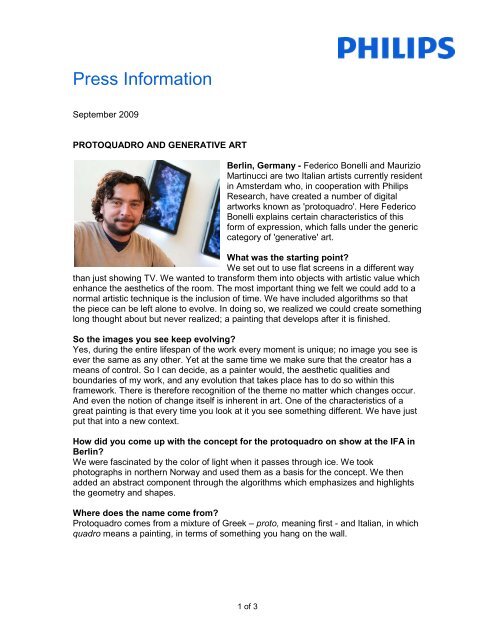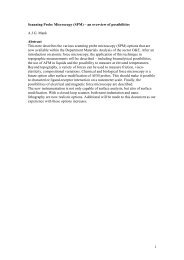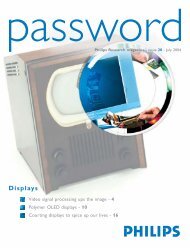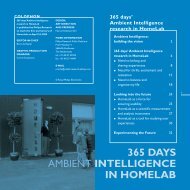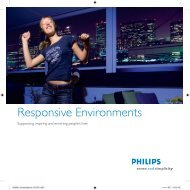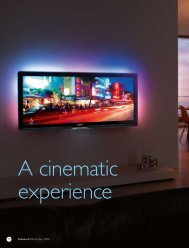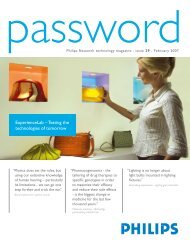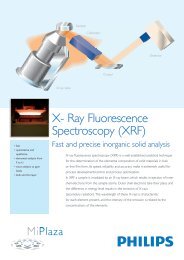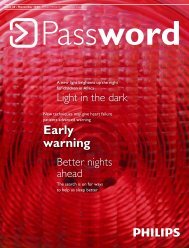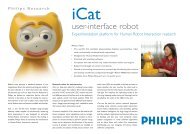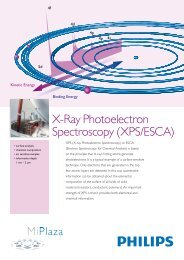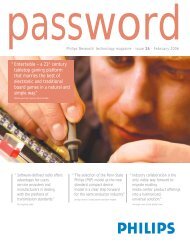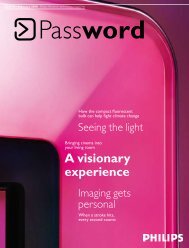+ Interview with Federico Bonelli, one of the ... - Philips Research
+ Interview with Federico Bonelli, one of the ... - Philips Research
+ Interview with Federico Bonelli, one of the ... - Philips Research
You also want an ePaper? Increase the reach of your titles
YUMPU automatically turns print PDFs into web optimized ePapers that Google loves.
Press Information<br />
September 2009<br />
PROTOQUADRO AND GENERATIVE ART<br />
Berlin, Germany - <strong>Federico</strong> <strong>B<strong>one</strong>lli</strong> and Maurizio<br />
Martinucci are two Italian artists currently resident<br />
in Amsterdam who, in cooperation <strong>with</strong> <strong>Philips</strong><br />
<strong>Research</strong>, have created a number <strong>of</strong> digital<br />
artworks known as 'protoquadro'. Here <strong>Federico</strong><br />
<strong>B<strong>one</strong>lli</strong> explains certain characteristics <strong>of</strong> this<br />
form <strong>of</strong> expression, which falls under <strong>the</strong> generic<br />
category <strong>of</strong> 'generative' art.<br />
What was <strong>the</strong> starting point?<br />
We set out to use flat screens in a different way<br />
than just showing TV. We wanted to transform <strong>the</strong>m into objects <strong>with</strong> artistic value which<br />
enhance <strong>the</strong> aes<strong>the</strong>tics <strong>of</strong> <strong>the</strong> room. The most important thing we felt we could add to a<br />
normal artistic technique is <strong>the</strong> inclusion <strong>of</strong> time. We have included algorithms so that<br />
<strong>the</strong> piece can be left al<strong>one</strong> to evolve. In doing so, we realized we could create something<br />
long thought about but never realized; a painting that develops after it is finished.<br />
So <strong>the</strong> images you see keep evolving?<br />
Yes, during <strong>the</strong> entire lifespan <strong>of</strong> <strong>the</strong> work every moment is unique; no image you see is<br />
ever <strong>the</strong> same as any o<strong>the</strong>r. Yet at <strong>the</strong> same time we make sure that <strong>the</strong> creator has a<br />
means <strong>of</strong> control. So I can decide, as a painter would, <strong>the</strong> aes<strong>the</strong>tic qualities and<br />
boundaries <strong>of</strong> my work, and any evolution that takes place has to do so <strong>with</strong>in this<br />
framework. There is <strong>the</strong>refore recognition <strong>of</strong> <strong>the</strong> <strong>the</strong>me no matter which changes occur.<br />
And even <strong>the</strong> notion <strong>of</strong> change itself is inherent in art. One <strong>of</strong> <strong>the</strong> characteristics <strong>of</strong> a<br />
great painting is that every time you look at it you see something different. We have just<br />
put that into a new context.<br />
How did you come up <strong>with</strong> <strong>the</strong> concept for <strong>the</strong> protoquadro on show at <strong>the</strong> IFA in<br />
Berlin?<br />
We were fascinated by <strong>the</strong> color <strong>of</strong> light when it passes through ice. We took<br />
photographs in nor<strong>the</strong>rn Norway and used <strong>the</strong>m as a basis for <strong>the</strong> concept. We <strong>the</strong>n<br />
added an abstract comp<strong>one</strong>nt through <strong>the</strong> algorithms which emphasizes and highlights<br />
<strong>the</strong> geometry and shapes.<br />
Where does <strong>the</strong> name come from?<br />
Protoquadro comes from a mixture <strong>of</strong> Greek – proto, meaning first - and Italian, in which<br />
quadro means a painting, in terms <strong>of</strong> something you hang on <strong>the</strong> wall.<br />
1 <strong>of</strong> 3
How difficult is it to master both <strong>the</strong> artistic side as well as <strong>the</strong> technical skills<br />
necessary to create a protoquadro?<br />
In different ages artists had to master many different skills. Few artists can make <strong>the</strong>ir<br />
own colors <strong>the</strong>se days, whereas in <strong>the</strong> times <strong>of</strong> Leonardo da Vinci, and even up to <strong>the</strong><br />
early industrial age, this was a pre-requisite. In that respect we are not being asked to do<br />
anything new.<br />
But if you consider <strong>the</strong> specific expertise we need, we do have knowledge <strong>of</strong> algorithms.<br />
For instance we've been developing <strong>the</strong> <strong>one</strong> driving <strong>the</strong> piece on show in Berlin since<br />
2006.<br />
<strong>Philips</strong> has helped us <strong>with</strong> technology that we did not have and could not<br />
develop.ourselves. This has enabled us to build up a lot <strong>of</strong> knowledge on what kind <strong>of</strong><br />
images works best and what kind <strong>of</strong> compositing tricks we can use. It's very exciting,<br />
because it allows us to create new objects that have never been thought <strong>of</strong> before.<br />
Which o<strong>the</strong>r 'generative artists' have inspired you?<br />
Brian Eno started working on sound that changed over time, algorithm-generated music,<br />
in Music for Airports in 1978. Our early work in 2004 was predominantly a visual<br />
enhancement <strong>of</strong> <strong>the</strong> philosophy behind <strong>the</strong> work he carried out in <strong>the</strong> 70s. To a certain<br />
extent some <strong>of</strong> <strong>the</strong> stuff Alexander Calder was doing in <strong>the</strong> 1940s could also be<br />
displayed as generative art. But to be h<strong>one</strong>st, I'm not particularly interested in <strong>the</strong><br />
universe <strong>of</strong> generative art practiti<strong>one</strong>rs. We just do our thing.<br />
How large a role does technology play?<br />
It's important but is only <strong>one</strong> part <strong>of</strong> <strong>the</strong> equation. The idea behind <strong>the</strong> protoquadro can<br />
be 2000 years old. Involving technology may allow you to do things faster, but if you put<br />
garbage in you still get garbage out. Making a quality end-result is a never-ending quest<br />
and is largely technology independent. One <strong>of</strong> <strong>the</strong> first protoquadro projects was on a<br />
small digital photo frame. It was so slow, much slower than on our computer, but <strong>the</strong> fact<br />
that it was changing so slowly gave it its own beauty.<br />
Working <strong>with</strong> <strong>Philips</strong>, we have scaled up our protoquadros to wallsized works and<br />
multiple screens. And <strong>Philips</strong> has, for example, applied its motion sensor technology to<br />
develop an interactive version <strong>of</strong> protoquadro that accelerates <strong>the</strong> speed at which <strong>the</strong><br />
image evolves when some<strong>one</strong> approaches.<br />
How many protoquadro artworks have you already created?<br />
We have made eight already. Each is available in a limited series <strong>of</strong> generally less than<br />
10. But even <strong>with</strong>in this limited series, if you run <strong>the</strong> same images on <strong>the</strong> same screen<br />
using <strong>the</strong> same algorithm <strong>the</strong>y will produce a different result. Even after five minutes <strong>the</strong>y<br />
would start to differ. In that respect every <strong>one</strong> is truly unique. We have already exhibited<br />
in <strong>the</strong> US, Germany, Italy and <strong>the</strong> Ne<strong>the</strong>rlands.<br />
What kind <strong>of</strong> comments do you get from <strong>the</strong> more conservative side <strong>of</strong> <strong>the</strong> art<br />
world?<br />
You have to remember that I come from Italy, where some people seem to think that if<br />
you haven't been dead for at least half a century you can't call yourself an artist or a<br />
philosopher! So you quickly learn not to bo<strong>the</strong>r too much about what is said.<br />
2 <strong>of</strong> 3
But don't you get people claiming that what you make is nothing more than a<br />
glorified screensaver?<br />
The artistic content is very high in <strong>the</strong> protoquadro; it will typically take us four months <strong>of</strong><br />
worki to make a new <strong>one</strong>. They can also run across multiple screens or even beyond <strong>the</strong><br />
confines <strong>of</strong> <strong>the</strong> screen, for instance through a projection. We also develop each piece<br />
specifically for <strong>the</strong> environment it will be shown in, so we have to consider how high it<br />
will be hung on <strong>the</strong> wall and <strong>the</strong> aes<strong>the</strong>tic balance inside <strong>the</strong> room. And remember, each<br />
<strong>one</strong> is a <strong>one</strong>-<strong>of</strong>f. It's also important to note that <strong>the</strong> protoquadro is all that happens on <strong>the</strong><br />
screen. It's not as if you would use it at o<strong>the</strong>r times to watch TV. The screen is <strong>the</strong><br />
platform for a piece <strong>of</strong> art, nothing else.<br />
For fur<strong>the</strong>r information, please contact:<br />
Hans Driessen<br />
Communications Department <strong>Philips</strong> <strong>Research</strong><br />
Tel.: +31 40 27 46 692<br />
Mobile: +31 6 10 610 417<br />
E-mail: hans.driessen@philips.com<br />
About Royal <strong>Philips</strong> Electronics<br />
Royal <strong>Philips</strong> Electronics <strong>of</strong> <strong>the</strong> Ne<strong>the</strong>rlands (NYSE: PHG, AEX: PHI) is a diversified<br />
Health and Well-being company, focused on improving people’s lives through timely<br />
innovations. As a world leader in healthcare, lifestyle and lighting, <strong>Philips</strong> integrates<br />
technologies and design into people-centric solutions, based on fundamental customer<br />
insights and <strong>the</strong> brand promise <strong>of</strong> “sense and simplicity”. Headquartered in <strong>the</strong><br />
Ne<strong>the</strong>rlands, <strong>Philips</strong> employs approximately 116,000 employees in more than 60<br />
countries worldwide. With sales <strong>of</strong> EUR 26 billion in 2008, <strong>the</strong> company is a market<br />
leader in cardiac care, acute care and home healthcare, energy efficient lighting<br />
solutions and new lighting applications, as well as lifestyle products for personal wellbeing<br />
and pleasure <strong>with</strong> strong leadership positions in flat TV, male shaving and<br />
grooming, portable entertainment and oral healthcare. News from <strong>Philips</strong> is located at<br />
www.philips.com/newscenter.<br />
3 <strong>of</strong> 3


